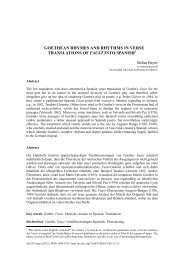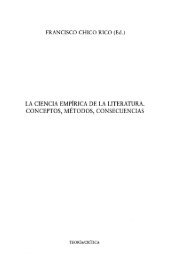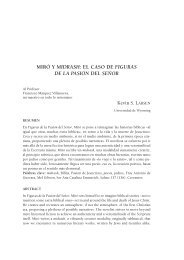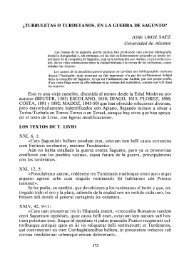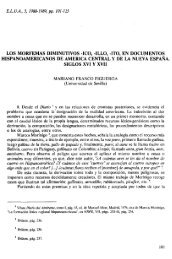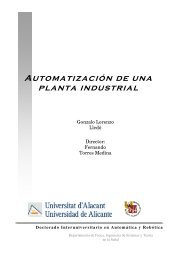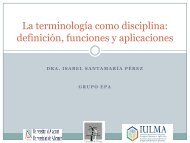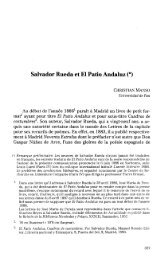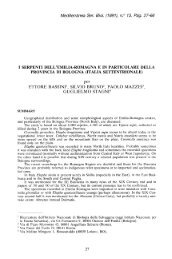Conceptual Metaphors in Taboo-Induced Lexical Variation
Conceptual Metaphors in Taboo-Induced Lexical Variation
Conceptual Metaphors in Taboo-Induced Lexical Variation
You also want an ePaper? Increase the reach of your titles
YUMPU automatically turns print PDFs into web optimized ePapers that Google loves.
<strong>Conceptual</strong> <strong>Metaphors</strong> <strong>in</strong> <strong>Taboo</strong>-<strong>Induced</strong> <strong>Lexical</strong> <strong>Variation</strong> 69<br />
8. See Keyes (2010: 25–28) for examples of novel X-phemisms that <strong>in</strong>volve Bill Cl<strong>in</strong>ton,<br />
Barack Obama or the US Senator Larry Craig.<br />
9. From this po<strong>in</strong>t of view, X-phemistic references from the field of professional writ<strong>in</strong>g serve<br />
the same purpose as jargon: to identify and differentiate group members from non-groups<br />
members. In this ve<strong>in</strong> Burridge (forthcom<strong>in</strong>g) considers that euphemism is a useful <strong>in</strong>strument to<br />
show solidarity and help to def<strong>in</strong>e the gang: “Shared taboos and the rites and rituals that<br />
accompany our euphemistic behaviour <strong>in</strong>crease group identity through feel<strong>in</strong>gs of dist<strong>in</strong>ctiveness;<br />
they strengthen the social fabric”.<br />
10. In a previous study I demonstrated that the conceptualization DEATH IS A REST/A SLEEP is<br />
pervasive to refer euphemistically to the taboo of death. In a sample of epitaphs from Highgate<br />
Cemetery (London), this conceptualization is, together with DEATH IS A JOURNEY, the most relevant<br />
from a quantitative po<strong>in</strong>t of view (29% of all the metaphorical cases detected) (Crespo Fernández<br />
2011).<br />
11. The notion of death as a sort of orgasm is a common euphemistic device <strong>in</strong> Cleland’s<br />
Memoirs of a Woman of Pleasure, first published <strong>in</strong> 1749. Orgasm is euphemized as agony, agony<br />
of delight, agony of bliss and die-away moment; and the act of reach<strong>in</strong>g orgasm as die, die away<br />
and expire.<br />
12. Accord<strong>in</strong>g to Chamizo Domínguez and Sánchez Bendito (2000: 91), the words that<br />
have been fully lexicalized with a sexual sense and have lost their literal mean<strong>in</strong>g are fuck,<br />
sard, swive ‘copulate’; p<strong>in</strong>tle, pizzle, putz, scmuck, tarse, w<strong>in</strong>kle, hard-on ‘penis’; and cunt,<br />
fanny, m<strong>in</strong>ge, qua<strong>in</strong>t, quim and twat ‘vag<strong>in</strong>a’. Accord<strong>in</strong>g to these scholars, seven out of these<br />
sixteen words are no longer present <strong>in</strong> modern usage.<br />
13. It is <strong>in</strong>terest<strong>in</strong>g to note that the OED2 reports that the cock metaphor for ‘penis’ does<br />
not come directly from the domestic fowl, but from a barrel tap <strong>in</strong> the shape of a cock’s nest.<br />
14. The use of pass away with the mean<strong>in</strong>g of ‘disappear slowly’ is less frequent than the<br />
mean<strong>in</strong>g related to death. In fact, as Bultnick (1998: 32) po<strong>in</strong>ts out, the Cobuild Dictionary<br />
<strong>in</strong>dicates that pass away is used “especially when to want to avoid say<strong>in</strong>g the word die”. This<br />
euphemistic sense is also of greater relevance <strong>in</strong> quantitative terms: 38 out of the 50<br />
occurrences of this expression encountered <strong>in</strong> the BNC present a euphemistic value <strong>in</strong> reference<br />
to the taboo of death.<br />
15. “Por los huevos” can be translated as both “because of the eggs” (the mean<strong>in</strong>g <strong>in</strong>tended<br />
by the woman) and “from the eggs” (the mean<strong>in</strong>g taken by the old man).<br />
References<br />
Allan, Keith and Kate Burridge (1991): Euphemism and Dysphemism. Language Used as<br />
Shield and Weapon. Oxford and New York: Oxford University Press.<br />
——— (2006): Forbidden Words. <strong>Taboo</strong> and the Censor<strong>in</strong>g of Language. Cambridge:<br />
Cambridge University Press.<br />
Ayto, John (2007): Wobbly Bits and Other Euphemisms. 2nd ed. London: A & C Black. (1st ed.<br />
1993, published as A Dictionary of Euphemisms).<br />
Barcelona, Antonio (2003): “Clarify<strong>in</strong>g and Apply<strong>in</strong>g the Notions of Metaphor and Metonymy<br />
with<strong>in</strong> Cognitive L<strong>in</strong>guistics. An Update”. In R. Dirven and R. Pör<strong>in</strong>gs, eds., Metaphor<br />
and Metonymy <strong>in</strong> Comparison and Contrast. Berl<strong>in</strong> and New York: Mouton de Gruyter,<br />
207–77.





